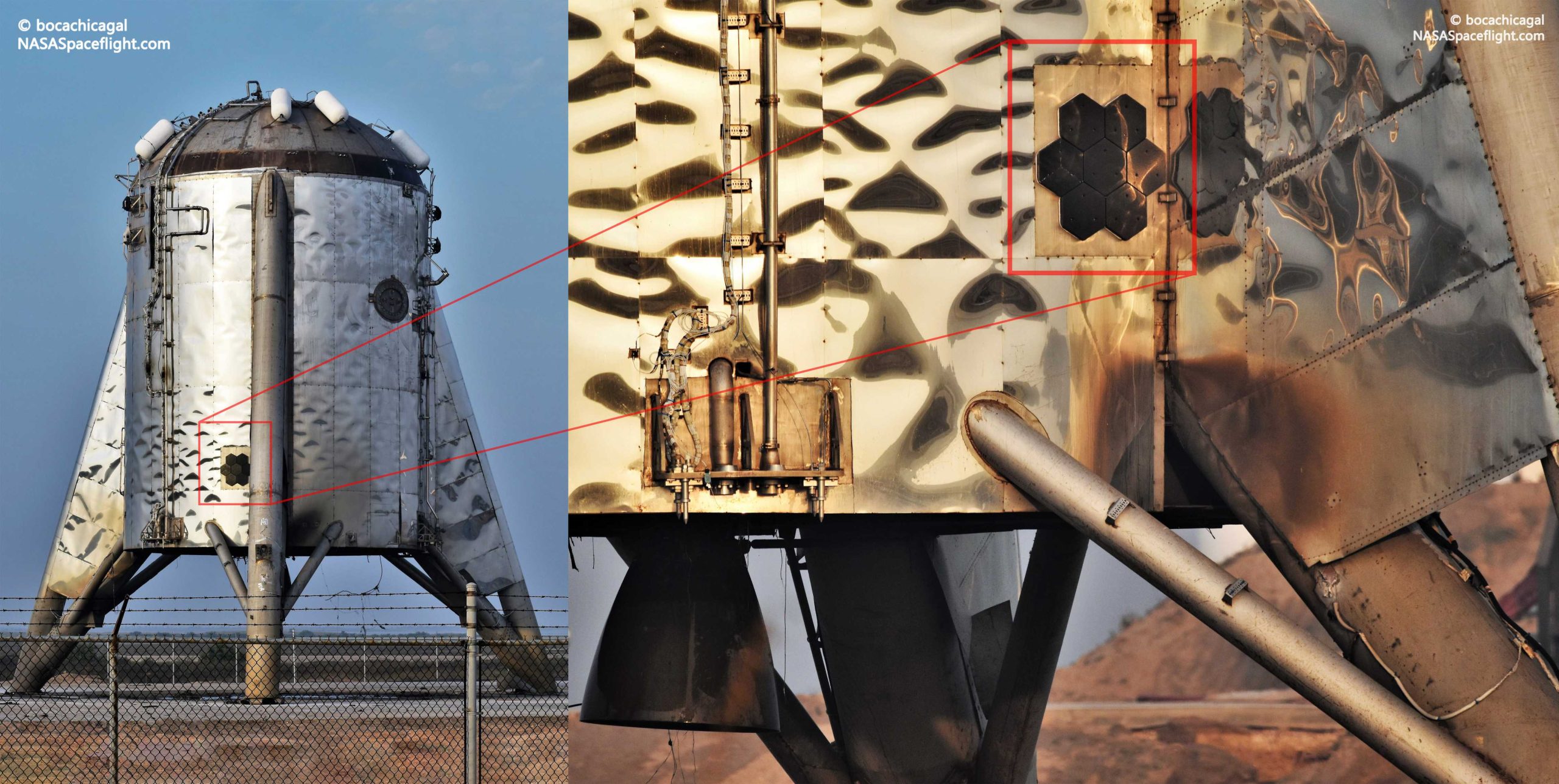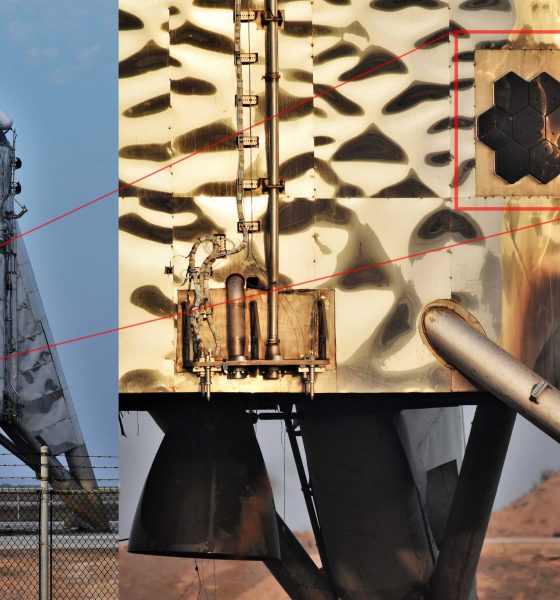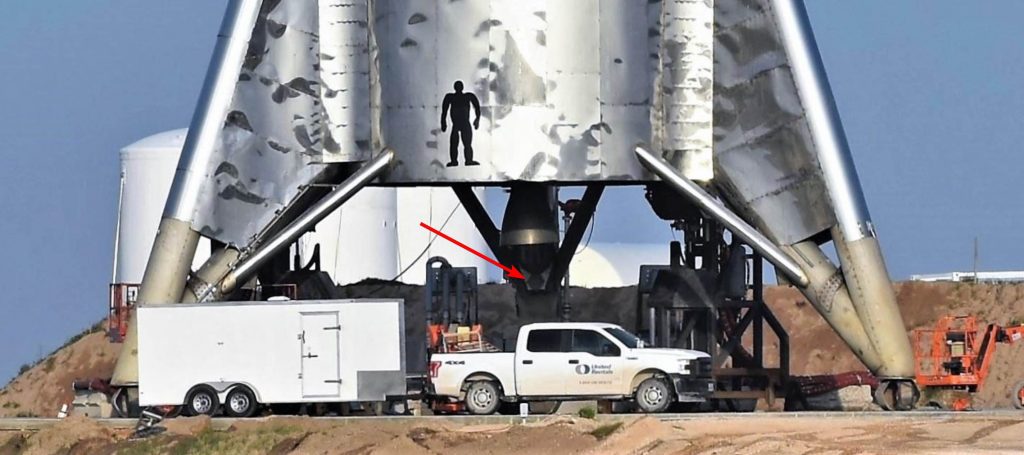

News
SpaceX tests ceramic Starship heat shield tiles on Starhopper’s final flight test
Although it flew under the radar in the heat of the moment, SpaceX’s final Starhopper test flight – completed on August 27th – happened to include an unusual bit of test hardware – eight (give or take) ceramic Starship heat shield tiles.
On the same day that Starhopper lifted off for the last time and completed a 150m (500 ft) hop test in South Texas, SpaceX Cargo Dragon capsule C108 wrapped up its third successful orbital mission, reentering Earth’s atmosphere with a complement of several ceramic Starship heat shield tiles. This marked the first known orbital test of Starship hardware on the same exact day that Starhopper was putting nearly identical tiles through an entirely different kind of flight test.
Tile #8
As pictured above, a group of seven hexagonal tiles appeared on Starhopper’s exterior around August 14th. Those tiles were black (somewhere between matte and glossy), featured indents likely related to manufacturing or mounting, and appeared to be attached to Starhopper by way of a white, marshmallow-esque adhesive. Altogether, each tile bears a striking resemblance to two-thirds of a hexagonal Oreo cookie, arranged in a grid and sort of squished onto Starhopper.

Aside from the seven tiles attached directly to the exterior Starhopper’s liquid methane tank, at least one additional tile was spotted on a small mount structure welded to the bottom of one of the vehicle’s tripod legs. Likely just five or so meters (~15 feet) away from Starhopper’s Raptor engine, that particular tile would have been subjected to intense heating and sound (i.e. thermal and acoustic shock) during the Starship testbed’s final ~60-second flight.
It is a busy morning at the Starship Hopper launch site!
⚙️/⬇️/? : https://t.co/zWfJdm095L pic.twitter.com/KL6azUo4Rd— ?Trevor Mahlmann (@TrevorMahlmann) August 26, 2019
In fact, the Raptor-facing tile may have been put through an even more stressful test than intended, owing to the apparent difficulties Raptor SN06 had during its minute-long performance. Whether the result of shoddy installation and plumbing or an issue with Raptor itself, the engine demonstrated some unusual behavior as it throttled down for Starhopper’s landing, turning its largely transparent exhaust plume into a massive flamethrower.
Raptor or adjacent plumbing also appeared to suffer some kind of leak just before landing, producing significant flames that clearly scorched Starhopper’s rear and destroyed a huge amount of cabling in the area, visible just below the hexagonal tile group. Likely related, several views of the test showed a COPV flying off – clearing having suffered an anomaly that broke it free from Starhopper – around the same time as the vehicle ended its hop with a hard landing.
Tiles on Starhopper?
This does raise the question: why were prototype Starship heat shield tiles attached to Starhopper, a distinctly suborbital prototype that never reached a speed of ~20 m/s (40 mph), let alone orbital velocity? Without actually performing a reentry, what value could be derived? Taken alongside the almost-simultaneous orbital reentry test of four separate Cargo Dragon-shaped tile prototypes, the likely explanation is actually pretty simple and serves as an excellent example of SpaceX’s agile approach to aerospace development.
The three separate tile locations (Starhopper’s tank and leg and Cargo Dragon’s heat shield) all delivered extremely unique test conditions to their respective ceramic tile prototypes. Attached directly to a cryogenic fuel tank, Starhopper’s seven-tile set was almost certainly meant to test methods of mounting a heat shield on a stainless steel tank. Those tiles went through several thermal cycles from propellant loading, spent weeks unprotected in hellish South Texas heat and humidity, and suffered through the shock of flight and a hard landing.
The lone Raptor-adjacent tile was subjected to heating from a live engine just a dozen or so feet away, along with all the brutal acoustic stresses associated with it, perhaps including an unintended fire during anomalous engine performance. Cargo Dragon C108’s four ceramic tiles were far closer to a full-fidelity test, although they were shaped for and attached to the spacecraft in a manner that minimized their one-to-one relevance to Starship’s likely shield design. Regardless of the level of the test’s fidelity, they still managed to survive a true-to-life orbital reentry with nothing more than some soot stains from Dragon’s normal PICA-X shield material.
In short, SpaceX (hopefully successfully) demonstrated a large number of Starship’s ceramic tile design requirements before an actual flight-capable Mk1 or Mk2 Starship is ready for comparable testing. Of course, the most important tests will involve a combination of all Starship-relevant conditions (Raptor engines, cryogenic tank-wall mounting, hexagonal tiles, weeks spent in space, orbital reentry, etc.) for a full-fidelity reentry campaign with an actual Starship prototype. SpaceX CEO Elon Musk says those tests could begin very soon – as early as October 2019 – and the suite of piecemeal Cargo Dragon and Starhopper tests that prototype tiles have already completed will undoubtedly grease the wheels towards that ambitious goal.
Check out Teslarati’s Marketplace! We offer Tesla accessories, including for the Tesla Cybertruck and Tesla Model 3.

News
Tesla FSD successfully completes full coast-to-coast drive with zero interventions
Tesla community members celebrated the milestone on X, and the feat earned praise from some of the electric vehicle maker’s executives.

A Tesla owner has successfully completed a full coast-to-coast drive across the United States on Full Self-Driving (FSD) Supervised. The trip was accomplished with zero interventions.
Tesla community members celebrated the milestone on X, and the feat earned praise from some of the electric vehicle maker’s executives.
FSD Coast-to-Coast
The coast-to-coast feat was accomplished by Tesla owner Davis Moss, who drives a stealth gray Model 3 with AI4 hardware. Based on data from the FSD database and a community tracker, the last 10,638.8 miles Moss drove in his Model 3 were completed using FSD 100% of the time. His vehicle is equipped with FSD v14.2.1.25, which was installed 12 days ago.
As per Moss in a celebratory post on X, his Model 3 was able to complete a full coast-to-coast drive across the United States in 2 days and 20 hours. His trip started at the Tesla Diner in Los Angeles, CA, and it ended in Myrtle Beach, SC. Overall, his trip spanned 2,732.4 miles.
“This was accomplished with Tesla FSD V14.2 with absolutely 0 disengagements of any kind even for all parking including at Tesla Superchargers,” Moss stated in his post. He also added in later comments that there were zero close calls during the trip.
Tesla community celebrates
The FSD milestone trip was widely lauded by members of the Tesla community, especially since a coast-to-coast drive with zero interventions has been cited by Elon Musk as a target since October 2016, when Autopilot 2.0 was unveiled. At the time, Musk initially estimated that a coast-to-coast drive across the United States should be possible by the end of 2017. Considering Moss’ feat in his Model 3, it appears that Elon Musk’s estimate was not impossible at all. It was just late.
Musk himself celebrated the milestone on X, and so did Tesla VP of AI Software Ashok Elluswamy, who wrote “World’s first fully autonomous coast-to-coast drive, done with Tesla self-driving v14. Congrats and thank you @DavidMoss!” in a post on X. The official Tesla North America account also celebrated the feat, writing “First Tesla to drive itself from coast to coast w/ FSD Supervised. 0 interventions, all FSD” on X.
Elon Musk
Elon Musk: Tesla Model Y is world’s best-selling car for 3rd year in a row
The Model Y has now established an impressive streak that would otherwise have been impossible before Tesla.

Elon Musk has announced that the Tesla Model Y has become the world’s best-selling car by volume for the third consecutive year, capping 2025 with another dominant performance.
The Model Y has now established an impressive streak that would otherwise have been impossible before Tesla.
Three years in a row
Musk posted on X: “Tesla Model Y is now officially the world’s best-selling car for the third year in a row!” The CEO’s comment echoed an update that Tesla included in its 2025 recap, which highlighted, among other things, the Model Y’s incredible streak.
The Model Y has held the title since 2023, outperforming traditional leaders like the Toyota RAV4 and Corolla thanks to its bang-for-the-buck nature and its stellar combination of practicality, performance, and tech. The Model Y is also lauded as one of the safest vehicles on the road, making it an ideal choice for families in key markets such as China.
An impressive 2025
The Model Y’s sales feat in 2025 is especially impressive considering the introduction of the vehicle’s new variant. Tesla’s changeover to the new Model Y across its global factories resulted in sales being paused for some time in the first quarter. As per Tesla’s Q1 2025 vehicle delivery and production report, “the changeover of Model Y lines across all four of our factories led to the loss of several weeks of production in Q1.”
This suggests that the Model Y’s sales remained strong in 2025 to the point where it could still claim the title of the world’s best-selling vehicle by volume, even with its sales being throttled during the first quarter of the year. It would then be interesting to see just how far the Model Y can go in 2026, especially considering the rollout of new variants like the six-seat extended wheelbase Model Y L, the affordable Model Y Standard, and the top-tier Model Y Performance.
News
Tesla shares epic 2025 recap video, confirms start of Cybercab production
The cinematic montage, posted by the official Tesla account on X, celebrated the company’s progress in EVs, energy, and Robotaxi development.

Tesla has released an epic year-in-review video for 2025, recapping some of its major achievements from refreshed models to autonomy breakthroughs and production ramps.
The cinematic montage, posted by the official Tesla account on X, celebrated the company’s progress in EVs, energy, and Robotaxi development while looking ahead to an even bigger 2026.
Tesla’s 2025 highlights recap
Tesla has had a busy 2025, as highlighted in the recap video. The video opened with Elon Musk explaining the company’s pursuit of sustainable abundance. A number of milestones were then highlighted, such as the rollout of FSD v14, Optimus’ numerous demos, the opening of the Tesla Diner in Hollywood, LA, the completion of the world’s first autonomous car delivery, and the launch of the Robotaxi network in Austin and the San Francisco Bay Area.
Tesla also highlighted several of its accomplishments over the year. As per the company, the Model Y was the year’s best-selling vehicle globally again, and Teslas became more affordable than ever thanks to the Model 3 and Model Y Standard. Other key models were also rolled out, such as the refreshed Model S and X, as well as the new Model Y, the new Model Y Performance, and the six-seat, extended wheelbase Model Y L.
The Megablock was also unveiled during the year, and the Supercharger Network grew by 18%. Over 1 million Powerwalls were also installed during the year, and the Cybertruck became the first EV truck to get both an IIHS Top Safety Pick+ award and an NHTSA 5-Star safety rating.
Cybercab production confirmed
Interestingly enough, Tesla also confirmed in its 2025 recap video that the production of the Cybercab has started. This bodes well for the vehicle, as it could result in the vehicle really being mass-produced in the first half of 2026. Elon Musk confirmed during the 2025 Annual Shareholder Meeting that Cybercab production should earnestly start around April 2026.
Musk has also noted that the Cybercab will be Tesla’s highest-volume vehicle yet, with the company aiming for an annual production rate of about 2 million units. “If you’ve seen the design of the Cybercab line, it doesn’t look like a normal car manufacturing line,” Musk said earlier this year. “It looks like a really high-speed consumer electronics line. In fact, the line will move so fast that actually people can’t even get close to it.”







